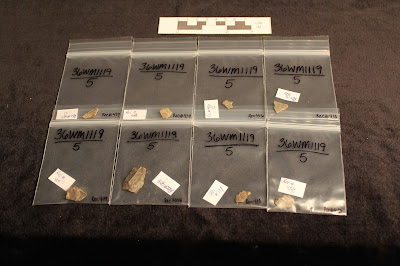W.P.A. excavations during Winter at the Peck Site (36So1)
Winter in Pennsylvania is not typically a time of year that
is well suited for archaeological fieldwork. That is not to say fieldwork in
February does not happen. Indeed, it has and does, but it would be difficult to
persuade anyone that conditions like the ones seen above are anything
approaching optimal. When the days are
short, cold winds bitter, and the ground is well, frozen, archaeologists often take to the lab to process (that is to
sort, clean, catalog, inventory, label and archivally package for curation)
artifact collections from the previous season’s excavations.
Here at the museum, artifact collections that are the
product of cultural resource management projects arrive year-round, although
there does seem to be an uptick in submissions this time of year. Being
centrally located as the State Museum is in Harrisburg, from time to time
criticism bubbles to the surface that our efforts and attention can focus disproportionately
on sites in the Susquehanna River Valley region. Given the diverse topography
and size of the state, wide ranging archaeological research interests, and our
own limited resources, this criticism is not without some merit. This week’s
post attempts to kill two birds with one stone in that it highlights an
artifact collection submitted for curation just two weeks ago (a “fresh”
collection so to speak), and that also happens to come from Westmoreland County
– a nod to our cohorts over the hills in the southwestern part of the state.
project overview photo with phase one shovel test in foreground (photo credit: McCormick Taylor, Inc.)
In 2016, McCormick Taylor Inc. conducted an archaeological
survey and evaluation for PennDoT’s proposed improvements to the highway
interchange of state routes 70 and 31 in South Huntingdon Twp., Westmoreland
County. As a recipient of federal highway tax dollars PennDoT is obligated to
make a good faith effort in identifying and evaluating cultural resources, and,
if necessary, mitigating any adverse effects their undertakings may have on
important historic and prehistoric sites.
modern disturbance and steep sloped portions of the project area not tested (photo credit: McCormick Taylor, Inc.)
After eliminating areas of the project determined to have
low archaeological potential due to modern disturbances or steep terrain, a
total of 228 shovel test pits and two 1m x 1m test units were excavated across
12 ½ acres of ground. As a result of their work, seven new archaeological sites
were recorded (36Wm1113 – 1119). Four of these sites consist of just 2 to 16
pieces of debitage each of local or regionally sourced cherts. The very low artifact density, and the lack of
diagnostic artifacts or cultural features were cited as justification to
recommend these sites as ineligible to the National Register of Historic Places,
and no further work was performed.
representative sample of lithic debitage from the Davis site (36Wm1119)
The Tignanelli site, 36Wm1113, comprised of mostly early 20th
Century kitchen wares, bottle glass and architectural material such as brick,
window glass and iron hardware, also contained about a dozen flake fragments of
local chert. This site too, was recommended ineligible to the NRHP, primarily
due to a lack of integrity and significance. There was one artifact in the
assemblage however, that did stand out amongst the 1200 more mundane bits that
is unique and worthy of a moment in the spotlight.
1937 Radio Orphan Annie decoder pin from the Tignanelli site (36Wm1113)
"mint" condition example
The 1937 Radio Orphan Annie decoder pin is a wonderful
object of popular culture that harkens back to the days before television, when
radio was king. It is easy to imagine that this, for a time, was probably a
child’s most prized possession, and of course it conjures up images of the
classic movie A Christmas Story, with
Ralphie feverishly cracking the code only to be rewarded with a reminder to
drink more Ovaltine. Not the type of thing to stop a transportation project in
its tracks, but a charming artifact all the same.
phase two excavation unit of the Davis site (photo credit: McCormick Taylor)
After the phase I survey, the final two sites, 36Wm1116 and
36Wm1119, were recommended to proceed to phase II, to determine their
eligibility to the National Register. As is the case with most cultural resource
management efforts, excavations were limited to the project’s area of potential
effects, or APE. For the Davis site, 36Wm1119,
this meant a limited view at what McCormick Taylor acknowledges in their report as a site that
in all likelihood extends beyond the project boundaries. The four phase two 1m x 1m
test units yielded 48 chert flakes in addition to the 25 pieces recovered from the
two phase one test units. Similar to the other sites identified for the
project, no features or datable diagnostic artifacts were found at 36Wm1119, and
consequently the portion of the site in the project area was deemed ineligible
to the Register.
Finally, for the Markle site, 36Wm1116, PennDoT successfully
modified the design of their project to avoid any potential impacts. In many
situations, avoidance constitutes an agreeable solution for all parties
involved, in that redesign is generally a less costly option for PennDoT as
opposed to labor intensive data recovery undertakings, and, while no additional
fieldwork is planned for, the site is nevertheless recorded and will (or, should)
remain undisturbed, thereby serving the interests of the cultural resource
community and ultimately the broader public.
Reference:
(2017) Brewer, Allison; Cristie Barry; Amanda Rassmusem
Phase IB/II Archaeological Identification and Evaluation
Investigations for the S.R. 0070 Section K10, S.R. 70/S.R. 31 Interchange
Improvement Project South Huntingdon Twp., Westmoreland County, PA
-report on file Section of Archaeology, State Museum of PA
For more information, visit PAarchaeology.state.pa.us or the Hall of Anthropology and Archaeology at The State Museum of Pennsylvania .









